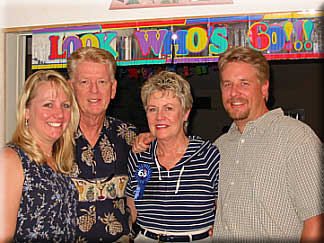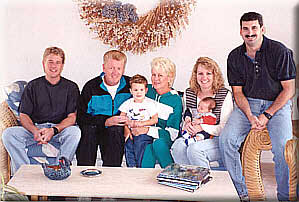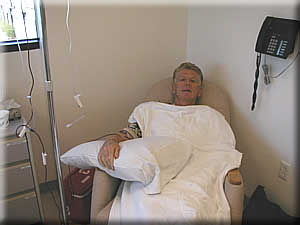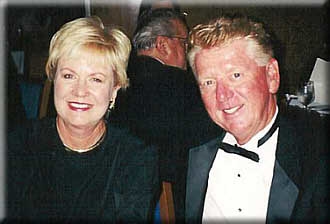Mesothelioma Disrupts Carefully Planned, Beautiful Lives
After 26 years in the corporate world, Ron Simkins retired early so that he and his lovely wife Janet could travel, spend more time with their grandkids, and enjoy the fruits of their labor. They bought a house in a golf resort community near Palm Springs. Their calendars were packed with golf, tennis, working out, bridge, gardening and other activities.
Ron's pursuit of fitness was more than a matter of keeping up physical or social appearances; he planned to live a very long and healthy life, and hoped to avoid heart disease and other troubles through a discipline of exercise and diet. His weekly regimen was more Olympian than retiree: five days of cardiovascular training and three days of weightlifting, intermixed with golf and tennis two to three times per week. The gym he belonged to named him "Fitness Member of the Month."
In early May, 2002, a few short days after public recognition of his devotion to health and fitness, Ron Simkins was privately advised that he had a rare and deadly form of cancer, and in that moment he saw his life's work collapsing like a house of cards.
Ron and Janet worked hard, they saved, they built a beautiful retirement home, they took care of their bodies, and they cherished each other and their family. Ron served his country in the US Navy. Little could they know that a lifetime of devotion to "the rules" was subverted years ago, when Ron was poisoned by asbestos exposure. Ron Simkins has malignant pleural mesothelioma.
AN ARRAY OF SYMPTOMS, A CLOUDY PICTURE
On October 12, 2001, Ron and Janet went on a Caribbean cruise. After returning from vacation in November, Ron returned to his workout schedule. He developed a pain on his left side and felt that he had pulled a rib cage muscle. The pain did not go away. On January 4, 2002, Ron developed a fever. Like most athletes, he put off going to the doctor as long as he could, confident that he could shake whatever was ailing him. His confidence was misplaced. Five days later, he finally consulted with his family physician.
Ron's doctor took a chest film, which showed a large cloud over the left lung cavity, suggesting that the left lung was filled with fluid. The working diagnosis was pneumonia, and the doctor prescribed antibiotics for ten days. Ron was told to return after completing the course of medication for a follow-up chest film.

Ron returned on January 18. The film showed a decrease in the amount of fluid, but nonetheless some fluid remained. His doctor seemed unconcerned and recommended "watchful waiting." For the next two months, Ron continued to feel sluggish, and his films continued to show what was clearly an abnormality, which over time progressed. Finally, Ron's family physician referred him to a pulmonary specialist.
On March 13, Ron had a CT scan which revealed a moderate amount of left pleural fluid that measured up to five cm in thickness. There was left pleural thickening, and some evidence of atelectasis (collapse or partial collapse of the lung). On March 27, Ron had a CT-guided aspiration of the left pleural effusion. The procedure removed 800 ccs of fluid. Ron's pulmonologist might have removed more, but detected hemorrhaging and terminated the procedure. The presence of blood was suspicious for cancer, but the pathologist who looked at the fluid found no evidence of malignancy.
Throughout April, a cloud continued to hang over Ron's medical picture. He was coughing and felt fatigued. His doctor again prescribed antibiotics for 10 to 14 days. But the fever returned again, along with a decrease in appetite and an overall weight loss of 10 pounds. Something was terribly wrong.
FINALLY, THE DAWN OF A TERRIBLE TRUTH
Ron's doctors increasingly discounted an infectious or inflammatory process. He was then referred to a thoracic surgeon who recommended a thoracotomy, decortication and pleurodesis. However, neither a PET scan nor a tissue biopsy was performed in advance -- two procedures which could have shed light on the source of Ron's health problem. Ron had surgery on May 1, at which time his surgeon found that the intercostal spaces had been obliterated by what he described later to Janet as "scar tissue."
Additionally, the surgeon found a 7mm thick fibrous peel on the left chest wall. He removed as much of the peel as was possible but later advised the Simkins that he was unable to remove the "scar tissue" abutting the esophagus and aorta. He then "cross-hatched" the lung in an attempt to expand it, drained the pleural effusion, and insufflated talc in the pleural cavity.
After surgery, the thoracic surgeon informed Ron that the "scar tissue" was the worst he had ever seen. He said it was so bad he could not peel it off. In order to cut out what he could see, the surgeon removed a rib. He sent the "scar tissue" to the pathology laboratory. After the surgery, again, there was no mention of "cancer" in the differential diagnosis. Two days later, the surgeon came to visit Ron in his hospital room. He called the pathology lab to learn the results. According to Janet, the surgeon was visibly shocked when he got the news the "scar tissue" was not only cancer, but a particularly rare and heinous form of cancer known as "malignant mesothelioma." The surgeon referred Ron to an oncologist and radiologist.
FROM LOCAL TUMOR BOARD, TO DR. CAMERON, TO ALIMTA
On May 4, Ron met with his oncologist. Because of Ron's youth and vigor, as well as the location and inoperability of the tumors, the oncologist advocated an aggressive therapy, but he did not have a particular regimen in mind, as he had little experience with mesothelioma. He indicated he would take Ron's case to the hospital's "Tumor Board," which would make a recommendation as to the best course, both for the patient and for Ron's HMO.

Ron was released from the hospital on May 4, after his chest tube was removed. Ron recuperated at his home on his favorite recliner, with vials of Oxycontin and Vicodin within easy reach.
On May 23, the Tumor Board recommended a repeat CT scan of the chest and a CT scan of the abdomen. Apparently, this quasi-official administrative decision was a prerequisite under Ron's HMO plan. The Board determined that because Ron's tumor was attached to his esophagus and aorta, further surgery was not recommended, and radiation was ruled out. The Board discussed a chemotherapy plan consisting of Cisplatin and Gemzar, even though a few days before at the American Society of Clinical Oncology ( ASCO) meeting several prominent oncologists touted Alimta as the new standard of care for unresectable mesothelioma.
Ron and Janet began researching their options. Palm Springs offered many amenities and opportunities for fun under the sun, but it was becoming painfully evident that local doctors were not armed to fight mesothelioma. The Tumor Board, to its credit, had advised that UCLA might have a program for patients like Ron. That is, even though they candidly admitted the tumors were "inoperable," perhaps another surgeon with greater experience would reach a different opinion.
So Ron and Janet set up an appointment with Dr. Robert Cameron at UCLA. Dr. Cameron is widely regarded as an expert in treating mesothelioma using pleurectomy / decortication, radiation and, if necessary, chemotherapy. Dr. Cameron's office graciously agreed to set up an emergency meeting consultation with Ron for June 3. A few days before, a CT scan revealed that Ron's left lower lung had collapsed, and the tumors encasing his left lung had progressed.
On June 3, Ron and Jan met with Dr. Cameron. After reviewing the medical records, Dr. Cameron was concerned about the unintended consequences of the May 1 surgery. Ron's surgeon did not know during the operation that the tissue he was cutting and peeling was malignant -- he thought it was "scar tissue." The question was therefore raised whether the procedure may have nicked the lung, diaphragm and/or other organs, thus opening a porthole for the tumor's spread.
A larger question was also raised about the techniques used or not used to reach the final diagnosis. Many times a surgeon will use PET scans and the tissue biopsy, among other tests, to narrow down the differential diagnosis. Unfortunately, not even a generic diagnosis of cancer was reached until two days after Ron's surgery.
Ron and Janet naturally have been disturbed by the apparent missed opportunities, but they have been undeterred. What's done is done, but now what? Let's talk about solutions.

Dr. Cameron suggested Alimta on a compassionate use basis. Alimta (pemetrexed disodium) is an antifolate that, in Phase III clinical trials in combination with Cisplatin, showed a 45% response rate in patients with malignant mesothelioma. The drug, manufactured by Eli Lilly, targets folic acid, which is crucial for tumor growth. Results of the completed Phase III trials were presented at the 38th annual meeting of the American Society of Clinical Oncology (ASCO) in Orlando, Florida, in May 2002, and have since been submitted to the Food and Drug Administration (FDA) for approval. Dr. Cameron wrote a letter to Ron's oncologist advocating that he contact Lilly about providing Alimta for Ron outside of its phase III protocol.
Thankfully, on June 19th, Lilly agreed to offer Alimta on a compassionate use basis. Finally, a ray of hope. The Simkins are proceeding forward with eyes wide open. They understand that Alimta is not a magic bullet or panacea. They hope it lives up to its potential as a life-extending chemotherapy" The plan is to attempt to shrink the tumor with Alimta and Cisplatin so that Dr. Cameron can later operate.
Before starting the regimen, Ron underwent a blood transfusion, because he was slightly anemic. On June 27, Ron had his first round of treatments. He is scheduled to have five more roughly every three weeks.
There's no way to sugarcoat it: contrary to press releases touting relatively mild side effects, the regimen can produce harsh consequences. Ron was very nauseated after the first infusion. The recurrent vomiting left him dehydrated, so he wisely sought treatment at the hospital, where he received an I.V. drip. The bad news was the doctors predicted nausea for at least five days. The good news is the doctors will be prepared for the next round to prescribe anti-nausea medication.
Although there is no "known" cure for mesothelioma (Janet emphasizes "known"), she says if there is a cure to be found, she will do everything possible to find it. She is on a mission and spends much of her time searching the Internet, and investigating all of the possibilities sent by friends and family. She says "after 38 years of marriage, I'm not going to let him go without a fight!" People speak of alternative medicine; Ron and Janet call it "complimentary" medicine, and are trying other things in addition to the conventional chemotherapy. And, their faith in God is a big part in Ron's recovery. They truly believe faith and hope are very powerful, and that miracles do happen.
THE MAN UNDER THE BLANKET
The Simkins have been careful planners. They planned to retire from the hustle and bustle of the corporate world at the age of 55. They planned to travel the world; Ron is "75% Swedish" and has always wanted to visit the homeland of his ancestors. They planned to enjoy and stretch out their lives by living in a golf resort community where they could exercise their minds and bodies.

Not surprisingly, they live in a house that is a testament to careful and wise planning. Their home is elegantly and comfortably furnished in an understated African safari theme. The art work is original and captivating. The great room sweeps the kitchen, dining room, bar and living room under one high ceiling. Tall glass windows and sliding glass doors showcase a hot tub, beautiful landscaping and an immaculately groomed golf course, where (no kidding) bunny rabbits frolick.
Now the Simkins are using that same penchant for careful planning to overcome a malady that shows no respect for a life well-lived. After overcoming the shock of the diagnosis, and the wall of denial that an intelligent person naturally builds around himself -- "this can't be happening to me, I've done everything right" -- Ron and Janet have channeled their considerable energy into fighting back. They have done their best to keep their emotions in check, and they continue to visit their grandchildren in San Diego. They recognize that normalcy itself is strong medicine.
Ron's recognition for his devotion to fitness came with this praise: "Congratulations, Ron: you are an inspiration to all of us." At the time, no one knew that an insidious cancer was incubating in Ron's chest. At the time, Ron's peers could see him peddling vigorously on the exercise bike, or climbing on the Stairmaster, or exploding his arms upward on the bench press -- an athlete pushing himself up to and beyond his limits.
But now we see something else: a man in a chair under a blanket, an intravenous line running into his arm from a bag that holds a toxic but potentially life-saving combination of drugs. The man dreams about the joys of golf, tennis, running and pumping his muscles, but the dream is broken by a dark curtain of melancholy slowly lowering over him. The man fights back, not with fist and bone or even drugs, but with the same powerful forces that have helped him excel as a father, husband, manager and friend. And, after a moment of reflection, the man in the chair under the blanket with the I.V. smiles.
*** POSTED JULY 18, 2002 ***
An Update -- 8/19/02 (From Janet)
To all of you who have emailed me or just have questions about Alimta.
My husband Ron is being treated with Alimta (Alimta/Cysplatin, with B-12 and Folic Acid). He just had his 3rd of 6 treatments on Friday (8/16). After his first treatment, he got very sick--vomiting, dry heaves, etc., and had to go back in for an I.V. of hydration and anti-nausea (Adavan?), which got him back on track. Starting with the second treatment, the onc. scheduled him to come back for those same hydration/anti-nausea I.V.'s for 2 days after every treatment. This has helped tremendously. The oncologist also gave him Zofran to take by mouth for several days, and Compuzine, if needed. Ron is the first patient to use Alimta at our cancer center, so we are more-or- less finding our way with what works.
His blood counts are hanging in there. The WBC, Platelets and RBC are in the normal range; the Hgb is slightly low.
After treatment #2, and giving himself 5 or 6 days to get "back on track" we took a 10 day vacation to see our son and some of our old friends. Ron felt really good and played a couple rounds of golf with our son. We are hopeful he continues to feel so well.
In addition to this treatment, we include prayer, positive thinking, good nutrition, and the support of friends and family in our fight against this horrible disease.
I again want to thank you for your thoughts and prayers; and of course all of you are in my prayers every day.
Janet
An Update -- 9/15/03
Ron completed his sixth and final cycle of Alimta and Cisplatin in October of 2002, chemotherapy which caused severe nausea and repeated vomiting so severe that Ron would lose 10 pounds at a time and require intravenous rehydration. This led to a last desperate attempt at surgical removal of the tumor in December, 2002 by one of the handful of surgeons in the country recognized as competent in treating mesothelioma, Dr. Robert Cameron.
Dr. Cameron opened Ron up using the same incision site used by the thoracic surgeon who had originally "cross-hatched" Ron's pleura. He removed more rib, because the surgery was going to require more room to maneuver. And then he encountered a whitish, yellowish, hard surface that felt "almost like cement" -- the mesothelioma tumor. He started off by trying to dissect the tumor off the inside of the ribcage, all the way up to the top of the chest. And in doing so, he encountered several areas where it was actually physically impossible to remove the tumor.
Dr. Cameron literally took a chisel, like one might find in a hardware store, and put his 200 pounds of weight against the tumor, and could not fracture the tumor from the rib. At this point, Dr. Cameron had spent an hour to 90 minutes trying to accomplish what normally could be done in 15 to 20 minutes. It was pointless to continue. Dr. Cameron aborted the procedure, and sewed Ron Simkins back up.
After recovering from the surgery, Ron slowly regained strength. He managed to get back out on the golf course, and even the tennis court -- at least until August, 2003, when he began to suffer from a bulging disc in his back, and other, more troubling symptoms. His appetite now is poor, and he is on Vicodin 24/7. Dr. Hedy Kindler has recommended treatment with an experimental drug called SDX102.
An Update -- 10/19/03
From Janet:
We have been on the go, back and forth between home and San Diego, with doctor appointments both places. Last week we were at Scripps. We now have 2 oncologists there. One is a regular onc, the other is a radiation onc. They are conferring with Dr. Hedy Kindler. We consulted with her in Chicago, a few weeks ago, after we fired our local onc. who was non-responsive. Dr. Kindler knew of 2 oncologists out here, one at USC, the other ar Scripps, so we decided to try Scripps. Our daughter and her family live in San Diego....and....our daughter is an RN, all of which will be helpful.
Ron had several scans last week and it showed his tumor is growing and spreading. There are new "spots" up and down his spine, as well as a large mass just below the clavicle. The radiation onc recommended radiation to 2 areas of the spine where Ron is having pain, and, to the area below the clavicle which is causing severe nerve problems to his left arm and hand. They cannot radiate all the spots on the spine, as that would cause the spine to crumble. The mass causing the nerve pain needs quick attention or he could lose the use of his arm. Radiation will start this week at Scripps. After completion of radiation he will immediately go on chemo--gemcitibine. Anyone here had any experience with gemcitibine? He has already had the best chemo--alimta/cisplatin, which kept him stable for 10 months.
The first of Sept. he went on Oxycontin for pain. The Oxycontin took his appetite away, and he was fatigued. Subsequently in a matter of 6 weeks he lost 30 lbs. He's off the Oxy, and now on Methadone, and his appetite has improved. One of my friends here on the listserv recommended Megace which also helped his appetite. I got some Instant Breakfast and put protein powder in it, and he seems to like it ok. At night he has a protein milk shake. But he still looks bad because of all the weight he lost. He's also on a steroid for about 15 days--dexamethasone. He has so many meds I had to make a chart, to keep track.
It's been so heartbreaking to see him waste away. I am praying he can build himself up again. Dr. Kindler didn't want to give him a trial drug because she didn't think he was strong enough right now, and with winter coming it would be too hard on him to commute from California. He's got a lot to go through yet, treatment-wise. I am just amazed at how brave and positive he still is, after getting the results of the latest scans, and feeling so lousy. And, he always wants me to minimize his condition to family and friends----he doesn't want them to worry. When someone asks him how he's doing, he always says he is good. I am trying to remain positive, but it's hard. I MUST be positive around Ron--for his sake.
I hate bringing this kind of news, but hopefully there might be something here of help to others. You never know. I continue to pray each day for all of you.
Love and hope,
Janet
Mr. Ron Simkins passed away on December 8, 2003
* * * * * *
Known for his friendly, outgoing personality Ron passed away Dec. 8, 2003 at age 62, surrounded by his adoring family. He died from Mesothelioma, a rare cancer caused by asbestos exposure while serving in the U.S. Navy.
Ron and his devoted wife Janet, were married over 39 years enjoying life to the fullest. Before moving to Rancho Mirage in 1998, they spent 21 years in Novato, California where Ron had retired after a 26 year career with TRW. Through the years they were always involved in the numerous activities of their loving children, Leslee & Scott.
Ron was a remarkable man committed to God and family, and loved by so many. Besides his family, his passions included golf, tennis, bridge and his beloved grandsons Anthony & Michael. He was an active member of Sacred Heart Catholic Church, and the Mission Hills Country Club where they lived.
Family and friends are invited to attend a funeral mass at Sacred Heart Catholic Church in Palm Desert, on Friday, December 12, 2003 at 9:00 am. A rosary will be recited at Sacred Heart Church at 7:00 pm on Thursday, December 11, 2003.
In lieu of flowers the family suggests memorial contributions be made to the Mesothelioma Applied Research Foundation (MARF), 1609 Garden Street, Santa Barbara, CA 93101 (Ph: 805-560-8942).


